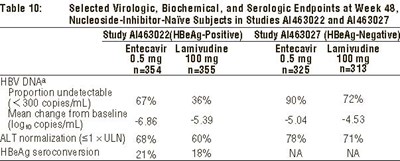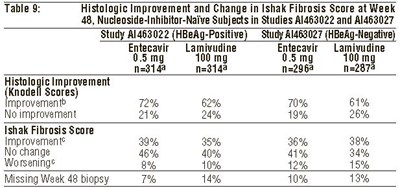Product Images Entecavir
View Photos of Packaging, Labels & Appearance
- Entecavir Tablet_0.5mg_222_30ct - Entecavir Tablet 0.5mg 222 30ct
- Table 10 - Table 10 Entecavir Insert
- Table 11 - Table 11 Entecavir Insert
- Table 12 - Table 12 Entecavir Insert
- Table 13 - Table 13 Entecavir Insert
- Table 14 - Table 14 Entecavir Insert
- Table 3 - Table 3 Entecavir Insert
- Table 4 - Table 4 Entecavir Insert
- Table 9 - Table 9 Entecavir Insert
- Structural Formula - structural formula entecavir
Product Label Images
The following 10 images provide visual information about the product associated with Entecavir NDC 61442-311 by Carlsbad Technology, Inc., such as packaging, labeling, and the appearance of the drug itself. This resource could be helpful for medical professionals, pharmacists, and patients seeking to verify medication information and ensure they have the correct product.
Table 10 - Table 10 Entecavir Insert

This is a comparison of selected virologic, biochemical, and serologic endpoints at week 48 for nucleoside-inhibitor-naive subjects in Studies Al463022 and Al463027. The study includes information on Entecavir and Lamivudine treatments for both HBeAg-positive and HBeAg-negative subjects. Key endpoints such as proportion of undetectable virus levels, ALT normalization, and HBeAg seroconversion are presented for each treatment group.*
Table 11 - Table 11 Entecavir Insert

This text presents data on histologic improvement and change in Ishak Fibrosis Score at Week 48 for Lamivudine-Refractory subjects in Study 41463026. The table compares the results between Entecavir and Lamivudine treatments. It shows the percentage of histologic improvement and no improvement based on Knodell Scores, as well as the change in Ishak Fibrosis Score with categories such as improvement, no change, and worsening. Additionally, the table indicates the percentage of missing Week 48 biopsies for both treatment groups.*
Table 12 - Table 12 Entecavir Insert

This text provides a snapshot of selected virologic, biochemical, and serologic endpoints at week 48 for Lamivudine-Refractory Subjects in Study Al463026. It compares the results between subjects treated with Entecavir and Lamivudine. Some of the key findings include the proportion of undetectable HBY DNA, average change from baseline in copies/ml, ALT normalization, and HBeAg seroconversion rates for both treatment groups. The results suggest a significant difference in treatment efficacy between Entecavir and Lamivudine in this study.*
Table 13 - Table 13 Entecavir Insert

This table shows selected endpoints at Week 48 for subjects with decompensated liver disease in Study AL463048. It compares the outcomes between patients receiving Entecavir and Adefovir Dipivoxil. Key findings include the percentage of subjects with undetectable HEV DNA, stable or improved CTP score, HBsAg loss, normalization of ALT, and other relevant data.*
Table 14 - Table 14 Entecavir Insert

This text provides virologic and biochemical endpoints at Week 24 for a study labeled Al463038. The data compares the results between two groups: the Entecavir treatment group and the Placebo group. The measures include the proportion of undetectable viral load (<300 copies/ml), the mean change from baseline in log10 copies/mL, and the percentage of ALT normalization. For example, the proportion of undetectable viral load at Week 24 was 6% in the Entecavir group compared to 0% in the Placebo group. Additionally, ALT normalization (≤1 x ULN) was achieved in 34% of patients in the Entecavir group compared to 8% in the Placebo group.*
Table 3 - Table 3 Entecavir Insert

This text provides a summary of clinical adverse reactions of moderate-severe intensity reported in four Entecavir clinical trials over a period of 2 years. It compares the reactions reported in patients who were Nucleoside-Inhibitor -Naive and Lamivudine-Refractory. The table includes data on different adverse reactions categorized by body system and the percentage of patients experiencing grades 2-4 adverse reactions. Adverse reactions such as diarrhea, dyspepsia, nausea, vomiting, fatigue, headaches, dizziness, somnolence, and insomnia are listed along with their respective occurrence rates in the trials.*
Table 4 - Table 4 Entecavir Insert

This is a table showing selected treatment-emergent laboratory abnormalities reported in four Entecavir clinical trials through two years. The abnormalities include ALT levels greater than 10 times the upper limit of normal (ULN), total bilirubin levels above 2.5 times ULN, hyperglycemia, creatinine levels above 3 times ULN, and more. The data presented reflects the percentages of occurrences for each abnormality in different treatment groups.*
Table 9 - Table 9 Entecavir Insert

This is a table showing the histologic improvement and change in Ishak Fibrosis Score at Week 48 for Nucleoside-Inhibitor-Naive subjects in studies AI463022 and A1463027. The table includes data for Entecavir and Lamivudine treatments at different dosage levels. It provides information on the percentage of subjects showing histologic improvement, no improvement, and changes in Ishak Fibrosis Score for both HBeAg-Positive and HBeAg-Negative studies. Additionally, it mentions the percentage of missing Week 48 biopsies in each treatment group.*
* The product label images have been analyzed using a combination of traditional computing and machine learning techniques. It should be noted that the descriptions provided may not be entirely accurate as they are experimental in nature. Use the information in this page at your own discretion and risk.

